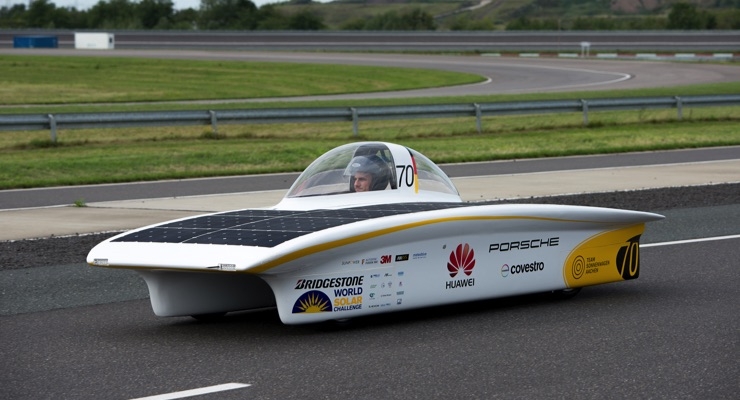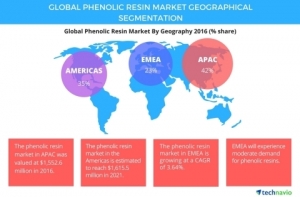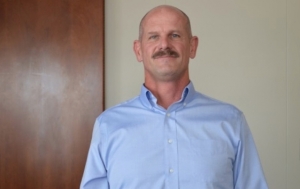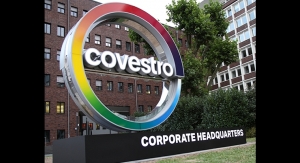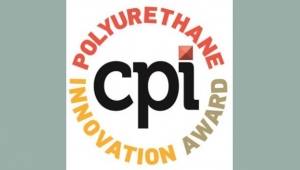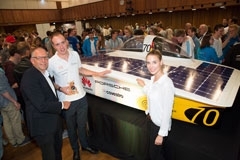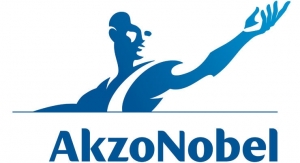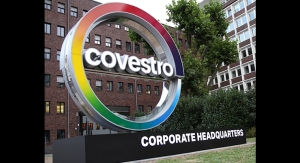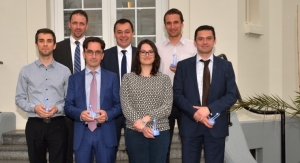09.22.17
Electric mobility and photovoltaics play a vital role in protecting the climate and conserving fossil resources. Combining them leads to even more innovative and sustainable mobility concepts. To show that these kinds of solutions are already feasible using state-of-the-art materials and technologies, a team of around 45 young researchers has developed a solar-powered electric car. Calling themselves “Team Sonnenwagen,” the students from RWTH Aachen University and Aachen University of Applied Sciences intend to enter their vehicle in the Bridgestone World Solar Challenge 2017 in Australia, arguably the toughest race in the world for solar cars.
Covestro is supporting the Sonnenwagen project with materials and technical service and as a gold sponsor. The company wants to use the project to test coatings under the harsh climate conditions prevailing along the race’s route. Temperatures in the Australian desert can soar to as much as 45˚C (113˚F) in October, with intense UV radiation. This time of year also typically sees a high particle concentration in the air.
Road test: automotive coating with sustainable raw material
The most important product application is a three-layer polyurethane coating from PPG, world leaders in paints, coatings and specialty materials, and experts in automotive coatings. The coating system is particularly suited to coating body parts made of carbon fiber composites. Climate conditions have a significant impact on the top clearcoat. The Sonnenwagen uses an innovative automotive refinish coating that contains Covestro’s bio-based hardener Desmodur eco N 7300.
“Some 70 percent of its carbon content comes from biomass,” said Ulf Wentzien, global head of Industrial Marketing in the Coatings, Adhesives, Specialties Business Unit at Covestro. “This reduces the environmental footprint by around 30 percent.”
“The bio-based hardener achieved the highest sustainability standards and meets both our customers’ and our own requirements,” added Ignasi Roig, EMEA product platform manager at PPG Refinish. “The coating is to the same outstanding quality as a polyurethane clearcoat with a conventionally produced hardener.”
Easy processing
The two-component coating is also impressive on the practical side. In PPG’s training center in Hilden, it was applied to the Sonnenwagen's bodywork parts under similar conditions to an automotive paint shop. [See video] The coating is particularly suitable for the temperature-sensitive surface of the solar-powered car as it hardens at low temperatures.
Covestro and PPG have been working together in the field of coatings development for many years now. Both partners are using the Sonnenwagen project to demonstrate the role coatings can play in sustainable mobility.
Tough test for solar cars
The World Solar Challenge celebrates its 30th anniversary this year. From Oct. 8 to 15, 2017, approximately 40 teams from all over the world will be competing in their “homemade” vehicles to win the 3,000 km (1864.114 mi) race from Darwin to Adelaide – without using one drop of fuel. The Sonnenwagen from Aachen will be the only German car going to the starting line in the Challenger Class this year.
Covestro has a long-standing partnership with the RWTH Aachen University.
“Through our developments and this project partnership, we are committed to future mobility and aim to show that these kinds of concepts are already feasible,” said Wentzien. “At the same time, we have the opportunity to inspire and support young people at universities.”
Photo courtesy Covestro
Covestro is supporting the Sonnenwagen project with materials and technical service and as a gold sponsor. The company wants to use the project to test coatings under the harsh climate conditions prevailing along the race’s route. Temperatures in the Australian desert can soar to as much as 45˚C (113˚F) in October, with intense UV radiation. This time of year also typically sees a high particle concentration in the air.
Road test: automotive coating with sustainable raw material
The most important product application is a three-layer polyurethane coating from PPG, world leaders in paints, coatings and specialty materials, and experts in automotive coatings. The coating system is particularly suited to coating body parts made of carbon fiber composites. Climate conditions have a significant impact on the top clearcoat. The Sonnenwagen uses an innovative automotive refinish coating that contains Covestro’s bio-based hardener Desmodur eco N 7300.
“Some 70 percent of its carbon content comes from biomass,” said Ulf Wentzien, global head of Industrial Marketing in the Coatings, Adhesives, Specialties Business Unit at Covestro. “This reduces the environmental footprint by around 30 percent.”
“The bio-based hardener achieved the highest sustainability standards and meets both our customers’ and our own requirements,” added Ignasi Roig, EMEA product platform manager at PPG Refinish. “The coating is to the same outstanding quality as a polyurethane clearcoat with a conventionally produced hardener.”
Easy processing
The two-component coating is also impressive on the practical side. In PPG’s training center in Hilden, it was applied to the Sonnenwagen's bodywork parts under similar conditions to an automotive paint shop. [See video] The coating is particularly suitable for the temperature-sensitive surface of the solar-powered car as it hardens at low temperatures.
Covestro and PPG have been working together in the field of coatings development for many years now. Both partners are using the Sonnenwagen project to demonstrate the role coatings can play in sustainable mobility.
Tough test for solar cars
The World Solar Challenge celebrates its 30th anniversary this year. From Oct. 8 to 15, 2017, approximately 40 teams from all over the world will be competing in their “homemade” vehicles to win the 3,000 km (1864.114 mi) race from Darwin to Adelaide – without using one drop of fuel. The Sonnenwagen from Aachen will be the only German car going to the starting line in the Challenger Class this year.
Covestro has a long-standing partnership with the RWTH Aachen University.
“Through our developments and this project partnership, we are committed to future mobility and aim to show that these kinds of concepts are already feasible,” said Wentzien. “At the same time, we have the opportunity to inspire and support young people at universities.”
Photo courtesy Covestro

